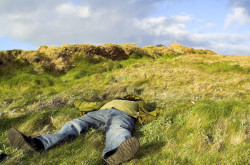 This complete breath exercise is my second post on breathing , if you missed the first one head over there for a good place to start if your new to breathing exercises. Or if you want to dive right in – go right ahead
This complete breath exercise is my second post on breathing , if you missed the first one head over there for a good place to start if your new to breathing exercises. Or if you want to dive right in – go right ahead
Complete breath….
Oftentimes the breaths we take aren’t complete. We’re not fully inflating our lungs and are usually just breathing into the upper lobes of our lungs. For greater health benefits, including less stress, less pain, more relaxation, and better oxygenation and function of our brains, muscles, and guts, we can train ourselves to breathe completely, using our diaphragms and inflating our lungs all the way from the bottom up to the top.
A full 360° of breath….
In the first post, we focused on belly breathing, placing our hands on our belly while lying with our legs up at 90º and pushing our hands up as high as possible with each breath. The goal is to use blow up the belly and keep the chest silent (unmoving). Make sure you’re comfortable belly breathing before you move on to the next step and can do it pretty reflexively.
To perform a complete breath, we start to focus on breathing into the diaphragm, not just the belly…
From the same position as before, lying on your back (level or with your legs on a bench or chair at 90°), you place your hands where your love handles would be instead of on your belly. Your goal with each breath is to push your hands out to the sides as much as possible. Think of it as pushing out on an inner tube around your belly.
You’ll notice your belly won’t rise as much but that is ok, as long as your chest is quiet (meaning all the action is in your belly and your chest isn’t moving with your breath). This is called east-west breathing (belly breathing is north-south) because the goal is to push out the sides horizontally as much as possible.
Along with the focus on pushing out your love handles (or where love handles would be), start thinking of the inhalation in three, smooth, continuous stages. All inhalation is through the nose, taking in as much air as possible.
Once you’ve got the belly breathing going, lets think about filling the lungs from the bottom up…
First, fully relax the belly and envision filling the lower portion of your lungs, drawing their air down to the bottom of your rib cage (this is what makes the belly rise and is what we practiced the first three days) and then expand out to your sides (pushing out tose love handles).
The next breath, add the second stage which is filling up the middle portion of your lungs. During this inhalation you’ll smoothly go from filling up the lower portion of your lungs as in step 1 (pushing up your belly and pushing out your sides) to filling up the middle portion by expanding the chest cavity and raising the rib cage. So fill belly first, then rib cage.
On the third breath, add the third stage, filling up the top portion of your lungs. During this inhalation you’ll smoothly transition from filling up the lower portion of the lungs (pushing out the belly/sides) then the middle portion of the lungs (filling chest cavity and raising rib cage), to filling up the upper portion, which will widen your shoulder blades and raise the collarbones. The chest will still move very little, think of it more as creating space in your torso and filling that space with air.
Get into the flow…
On all subsequent breaths, all three stages should smoothly flow together. Filling the belly/pushing out the sides, expanding the chest cavity and pushing up the ribs, and finally pushing out the shoulder blades and collarbones – fully filling the lungs with air.
Each breath should be long, slow, and deep, really focusing on filling up the lungs from the bottom up (instead of our normal top down).
Don’t forget about exhaling…
Exhalation is the opposite sequence until we fully drain all of the air out of the bottom of our lungs.
First empty the top of the lungs, then the middle of the lungs/ribcage, then the lower part of the lungs – forcing every last bit of air out by pulling the belly in to get that last bit out.
The exhalation should also be long and slow and you should feel empty of air. With the last bit of air exhaled, the last bit of tension will also be released and you should feel relaxed and calm. This is the quietest part of the breath sequence before taking your next long, slow, deep inhale and repeating the sequence.
Now your breathing with complete breaths!
Once you get used to and comfortable with the sequence, perform at least 30-40 deep breaths each day.
It can also be repeated at any time during your day from any comfortable position. It’s great way to start or end your day, to do when you’re feeling stressed, nervous, or anxious, or just to recenter yourself when you feel a bit overwhelmed or like you need a mini-break. It only takes a few minutes yet it does wonders for you in mind, body, and spirit!
As always – thanks for reading my post! Now go breathe…
References
Williams, J.M. (2010). Relaxation and Energizing Techniques for Regulation of Arousal. In J.M. Williams (ed.) Applied Sport Psychology: Personal Growth to Peak Performance. New York: McGraw Hill.
